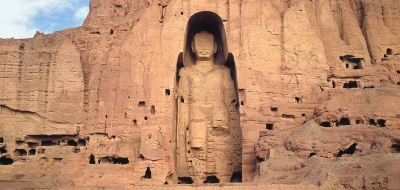
The 2001 destruction of the two giant Buddhas in Bamiyan is, by far, the most spectacular attack against the historical and cultural heritage of Afghanistan committed during the country’s recent period of turmoil.
The statues represented a later evolution of the classic blended style of Gandhara art. The statues consisted of the male Salsal (“light shines through the universe”) and the (smaller) female Shamama (“Queen Mother”), as they were called by the locals. The main bodies were hewn directly from the sandstone cliffs, but details were modeled in mud mixed with straw, coated with stucco. This coating, practically all of which wore away long ago, was painted to enhance the expressions of the faces, hands, and folds of the robes; the larger one was painted carmine red and the smaller one was painted multiple colors. The lower parts of the statues’ arms were constructed from the same mud-straw mix supported on wooden armatures. It is believed that the upper parts of their faces were made from great wooden masks or casts. The rows of holes that can be seen in photographs held wooden pegs that stabilized the outer stucco.
The Buddhas are surrounded by numerous caves and surfaces decorated with paintings. It is thought that the period of florescence was from the 6th to 8th century CE, until the onset of Islamic invasions. These works of art are considered as an artistic synthesis of Buddhist art and Gupta art from India, with influences from the Sasanian Empire and the Byzantine Empire, as well as the country of Tokharistan.
The statues were blown up and destroyed in March 2001 by the Taliban, on orders from leader Mullah Mohammed Omar, after the Taliban government declared that they were idols. International and local opinion strongly condemned the destruction of the Buddhas.
Picture Credit : Google

